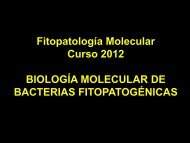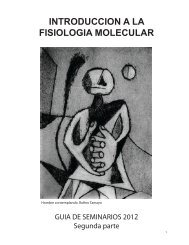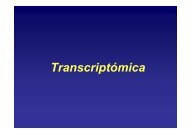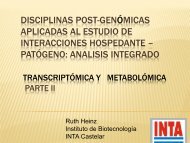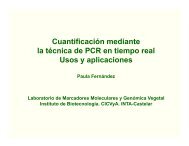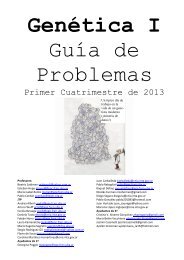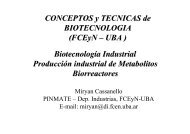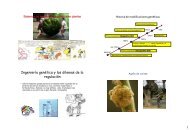Reacción en cadena de la polimerasa (PCR) - FBMC
Reacción en cadena de la polimerasa (PCR) - FBMC
Reacción en cadena de la polimerasa (PCR) - FBMC
You also want an ePaper? Increase the reach of your titles
YUMPU automatically turns print PDFs into web optimized ePapers that Google loves.
Transfer column to a clean tube and spin for another 1<br />
min at 13K<br />
Transfer column to a clean tube and add add 20μl MilliQ<br />
H2O pH 7-8.5 (wh<strong>en</strong> using<br />
22x50mm LifterSlips). Wait 1 min. Spin 1 min at 13K.<br />
Add another 20 μl MilliQ H2O, wait 1 min and th<strong>en</strong> spin<br />
at 13K for 1 min.<br />
Hybridisation<br />
Mix:<br />
39.4μl purified <strong>la</strong>belled probe<br />
12μl filtered 20x SSC 20% 9.2<br />
8.2μl filtered 2% SDS 14% 6.4<br />
Remove any dust from sli<strong>de</strong> and cover slip using an air<br />
duster<br />
P<strong>la</strong>ce a 22x50mm LifterSlip over arrayed area of sli<strong>de</strong><br />
D<strong>en</strong>ature probe at 95ºC for 2 min<br />
Towards <strong>en</strong>d of 2 min incubation, p<strong>la</strong>ce 30μl 3xSSC in<br />
each well of the hybridisation cassette<br />
Briefly spin down probe and immediately transfer to<br />
arrayed area of sli<strong>de</strong>, avoiding bubbles<br />
Seal hybridisation chamber<br />
Incubate in 65ºC water on top of p<strong>la</strong>stic base insi<strong>de</strong> bath<br />
for 16-20 hrs<br />
Washing<br />
Solutions Wash A Wash B<br />
20x SSC 20ml 2.4ml<br />
20% SDS 1ml -<br />
ddH2O to 400ml to 800ml<br />
Pre-heat wash A (1xSSC, 0.05%SDS) at 65ºC<br />
Add to pre-heated staining trough at 65ºC<br />
Remove microarray sli<strong>de</strong>s from hybridisation cassette<br />
and p<strong>la</strong>ce them in sli<strong>de</strong> rack Wash sli<strong>de</strong>s carefully<br />
in staining trough of wash A at 65ºC to remove<br />
LifterSlip Once LifterSlip is disp<strong>la</strong>ced continue<br />
agitating in wash A for a further 2min<br />
Transfer sli<strong>de</strong>s to new rack and wash in first trough of<br />
Wash B (0.06xSSC) for 2min<br />
Wash in second trough of Wash B for 2min<br />
Dry by spinning in 50ml c<strong>en</strong>trifuge tube at 1500rpm for<br />
5min<br />
Notes<br />
G<strong>en</strong>eral precautions and tips<br />
• Minimise the exposure of Cy-dyes to the light.<br />
• Use RNase-free pipette tips and H2O for RNA <strong>la</strong>belling<br />
reaction.<br />
• RNA preps should be at a conc<strong>en</strong>tration of at least<br />
0.35-0.7 μg/μl and purified using Rnasy columns (Qiag<strong>en</strong>).<br />
Labelling effici<strong>en</strong>cy<br />
• If the MinElute membrane remains white after<br />
binding of cDNA do not proceed, your RNA did not<br />
yield <strong>la</strong>belled cDNA. Check the quality of the RNA<br />
and/or the other reaction compon<strong>en</strong>ts and store the<br />
<strong>la</strong>belled gDNA at 20ºC for use in another hybridisation.<br />
• If the column is purely red or blue after binding<br />
Application Vol. Cy3- Vol. Cy5-dCTP<br />
cDNA vs dCTP 1.5μl 2.5μl<br />
cDNA vs ge- 1.5μl (gDNA) 2.5μl (cDNA)<br />
nomic g<strong>en</strong>omic vs 1.5μl 1.5μl<br />
pooled g<strong>en</strong>omic cDNA <strong>la</strong>bellings elute and re-<strong>la</strong>bel the failed<br />
reaction.<br />
Hybridisation tips and tricks<br />
• Once SDS has be<strong>en</strong> ad<strong>de</strong>d to the probe keep it at<br />
room temperature to avoid precipitation.<br />
• Transfer of the probe to the sli<strong>de</strong> must be done carefully<br />
but quickly to prev<strong>en</strong>t re-naturation of probes and<br />
ext<strong>en</strong><strong>de</strong>d evaporation of the sample.<br />
• Prepare the sli<strong>de</strong> and cover slip by removing any dust<br />
with pressurised air<br />
• Apply the probe as a line in the middle of the spotted<br />
area avoiding touching the sli<strong>de</strong> surface and bubble formation.<br />
This is best achieved by not expelling the final<br />
drop of liquid.<br />
• Using curved-edge forceps p<strong>la</strong>ce one edge of the cover<br />
slip just outsi<strong>de</strong> the spotted area at an angle to the sli<strong>de</strong><br />
surface. Hold a microspatu<strong>la</strong> down on the sli<strong>de</strong> surface<br />
close to (or just touching) the cover slip to prev<strong>en</strong>t it<br />
from sliding away from the arrayed area. Carefully lower<br />
the other edge of the cover slip down with the forceps<br />
and <strong>la</strong>y it down on the probe, which should spread out<br />
un<strong>de</strong>r the cover slip.<br />
• Once in p<strong>la</strong>ce do not move the cover slip (unless it is<br />
misp<strong>la</strong>ced accid<strong>en</strong>tally).<br />
• Small bubbles usually migrate out of the cover slip.<br />
Check after a few minutes in the water bath and if necessary<br />
g<strong>en</strong>tly tap the cover slip to dislodge any stubborn<br />
ones.<br />
• Wash the microspatu<strong>la</strong> and forceps in betwe<strong>en</strong> sli<strong>de</strong>s<br />
if they come into contact with the probe.<br />
Washing and drying sli<strong>de</strong>s<br />
• Do not touch the arrayed area, ev<strong>en</strong> with gloves<br />
• Wash by vigourously plunging the rack up and down<br />
for the whole wash time<br />
• Minimise exposure of the sli<strong>de</strong> to the air during washing<br />
• SDS is fluoresc<strong>en</strong>t - be particu<strong>la</strong>rly careful of what is<br />
on your gloves.<br />
TP 9: Demostración <strong>de</strong> electroforesis bidim<strong>en</strong>sional <strong>de</strong> proteínas (<strong>de</strong>mostrativo, no hay guía)<br />
TP 10: G<strong>en</strong>ómica funcional: Sil<strong>en</strong>ciami<strong>en</strong>to génico inducido por virus (VIGS)<br />
Preparado y <strong>en</strong>señado por Gabrie<strong>la</strong> L<strong>la</strong>uger, María Cecilia Rodríguez, Carlos Manacorda<br />
Introducción<br />
Página 18 <strong>de</strong> 40



